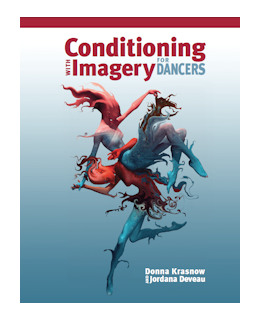


Jordana Deveau, Belinda McGuire, Chad Clark, Meredith Thompson, Natasha Poon Woo, & Sam Xu. |
Conditioning with Imagery for Dancers is an invaluable resource for dancers and dance educators. The book includes detailed descriptions of the purpose, form, and rhythm of more than eighty exercises, fully illustrated with step-by-step photographs. Each exercise is also supported by accompanying imagery to assist dancers as they work through the program.
The book also provides notes for teachers, suggestions for transferring material to standing and moving through space, balancing exercises, and other supporting material.
180 pages, paper
Order via Thompson Books or via
Amazon. You can also order via a local bookstore using the ISBN 978-1550772074.
People ordering from Amazon in Australia, Canada or the UK are recommended that they use the following country specific URLs:
ABOUT THE AUTHORS
TABLE OF CONTENTS
Section 2. C-I Training - The Method
Section 3. Appendices
REVIEWS
Book Review by Gigi Berardi
In Conditioning with Imagery for Dancers, authors Donna Krasnow and Jordana Deveau
make a strong case for C-I Training™ (conditioning-with-imagery) as a highly effective
system for neuromuscular patterning. Krasnow, a former professor in the Department of
Dance at York University in Toronto, has developed C-I Training™ as a conditioning
technique designed specifically for dancers. The technique focuses on integrating the
physical work of conditioning with the systematic neuromuscular patterning aspect of
various somatic practices. It is, in effect, a way for the brain to learn to “speak” to the
muscles.
The C-I Training™ system incorporates exercises to develop muscular strength,
endurance, and flexibility, as well as visualization work. It offers a good warm-up before
class or rehearsal, as well as a way to enhance technique and condition for injury
prevention. Krasnow and Deveau draw heavily from the earlier contributions of Sally Fitt,
Ruth Solomon, Zena Rommett, and imagery-work exemplars Lulu Sweigard, Irmgard
Bartenieff, and Irene Dowd. Hatha yoga classes and Qi Gong are examples of other
sources of inspiration. Divided into an introductory section and a C-I Training/Method
(followed by useful appendices), this comprehensive text is contemporary, relevant, and
user-friendly.
Clarity in Conditioning with Imagery is exceptional, from the detailed outline of the text
(over 100 separate small sections with exercises) to definitions of terminology and the
outlining of principles throughout. I found particularly interesting discussions of tonic
(slow twitch) and phasic (fast twitch) fiber systems and, early on, principles of the C-I
Training™ system, such as integration of the entire body, progression of the system
over time, importance of alternating work in muscular strength, muscular endurance,
and flexibility, specificity of exercises to particular dance practices, and attentiveness to
aspects that affect the quality of work, such as breath, timing, and transitions.
The exercises in Conditioning with Imagery can easily be performed as a continuous
progression, with transitions that are specifically choreographed. Many of the exercises
are challenging, in particular the développé and rond de jambe series. Almost all the
exercises work, as they should, the core, from those in prone position (beats in low
arabesque), to patterning exercises for the arms. In the final pages, postural problems
and muscle imbalances are addressed through a useful chart, with the muscle
imbalance or dysfunction specified (for example rounded shoulders, tight hip flexors,
tight calves, and underused inner thighs), as well as the specific exercises that address
the weakness. This practical book also addresses more abstract concepts, for example,
rate of progression, as in this quote (which also exemplifies the expert use of imagery):
One clear message in the book is that it is as important to feel the images as well as to
think or will them. To aid in this understanding, the authors include thorough
descriptions of the exercises, imagery sidebars, and exceptionally sharp and clear
photographs of dancers performing them. To ensure that every detail is accounted for,
descriptions include dozens of prepositional phrases. Some of the exercise titles
themselves are skillfully pictorial, such as “open and close the book” (side-to-side
rolling), “walking in space” (hip flexion), “the big X” (core initiation), “peel the banana”
(turnout exercise), “shrugs” (descending scapulae), “flying bird” (chest lifts on 3s with
arms behind), and “egg stretch” (final rest).
Krasnow and Deveau have written a text that is appropriate for a wide audience, from
young children (provided they are aided by experienced teachers) to advanced dancers.
Additional information is available through a DVD series, as well as a teacher
certification program. I highly recommend this text as an essential resource in dance
practice for educators, clinicians, and dancers alike.
LINKS
Book Cover Illustration by artist and retired dancer Martin Murphy
Headshots & Interior Photography by Gary Ray Rush
Website Design by designSEO.ca
Amazon.com / Conditioning with Imagery for Dancers
Conditioning with Imagery for Dancers
ISBN 978-1550772074
November 2010
$36.95 USD
Donna Krasnow is professor emerita in the Department of Dance at York University in Toronto, Canada, and until her retirement, she was teaching at California State University Northridge and California Institute of the Arts. She has been an international guest artist at many colleges, universities, and professional training institutions including Victorian College of the Arts in Melbourne, Australia; Western Australian Academy of Performing Arts in Perth, Australia; Osaka University of Health and Sport Sciences in Osaka, Japan; Arts Umbrella in Vancouver, Canada; and Canadian Contemporary Dance Theatre in Toronto, Canada. She was the founding artistic director of Möbius Dance Company in San Francisco, California, and has performed, taught, and choreographed extensively in the United States, Canada, Australia, and Japan. Her published books include Conditioning with Imagery for Dance with co-author Jordana Deveau, Motor Learning and Control for Dance: Principles and Practices for Performers and Teachers with co-author Dr. Virginia ("Ginny") Wilmerding, and Dancer Wellness with co-editor Dr. Virginia ("Ginny") Wilmerding, a collaborative project with IADMS. Her current project is writing the biography of Daniel Lewis, well-known dance artist, choreographer, and educator. For Donna’s full biography, visit Donna Krasnow's biography.

Jordana Deveau has been an active force in the Toronto dance community for over a decade. A principal performer with CCDT since 1994, her passion and skill launched her into the roles of Rehearsal Director and then Associate Artistic Director, where she trained future generations of dance artists for 7 years. Now pursuing an independent career, Jordana is the Co-Artistic Director, with Jesse Dell, of JD Dance and a founding member and Rehearsal Director of Event Horizon Dance directed by Miranda Abbott. She has trained in Toronto, Vancouver, New York and Vienna, and audiences have enjoyed her performances in the U.S, Europe and across Canada. She has performed in works by notable choreographers including Carol Anderson, Peggy Baker, Sidra Bell, David Earle, Kate Franklin, Margie Gillis, Andrea Nann, Roger Sinha, Holly Small, Santee Smith, and Gerry Trentham. When not on stage, she works in the community as an educator, rehearsal director and workshop facilitator.

Headshots by Gary Ray Rush
Section 1. Introduction
Journal of Dance Medicine & Science, Volume 16, Number 3, 2012, pages 135-136
It is important not to progress through the variations too quickly. If the
dancers feel cracking and snapping in the hips, the first strategy to attempt
is to deepen the narrowing and hollowing. Also, encourage use of the
images of reaching the leg away from the pelvis into space and seeing the
surface muscles softening and elongating. If the snapping persists, try
reducing the range of motion, and if nothing seems to achieve a smooth
action, it may mean the dancers should return to a simpler variation.